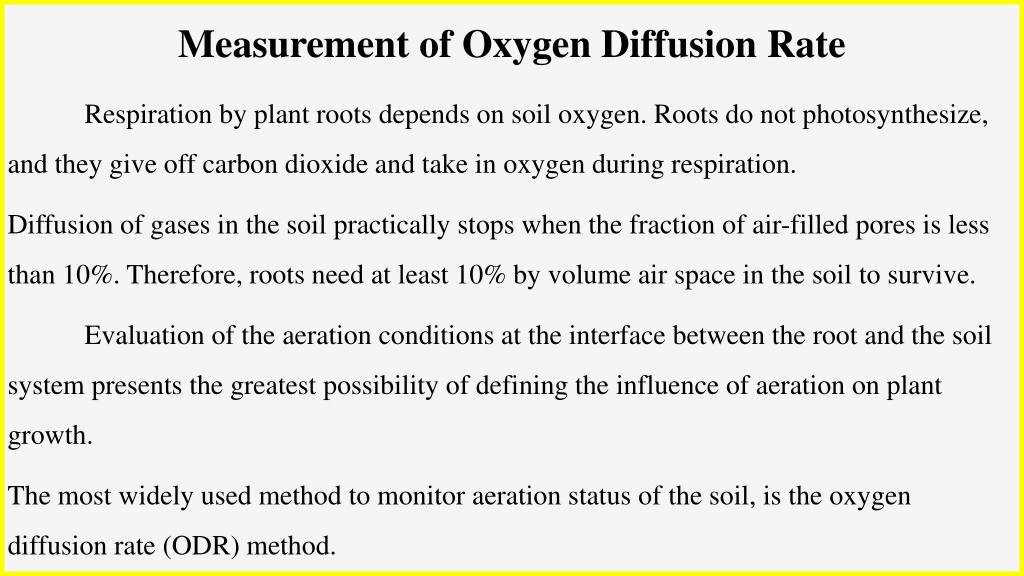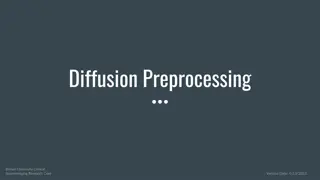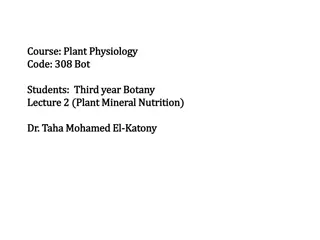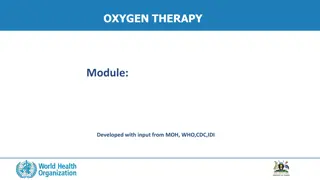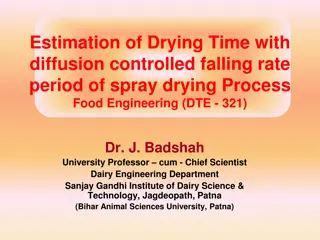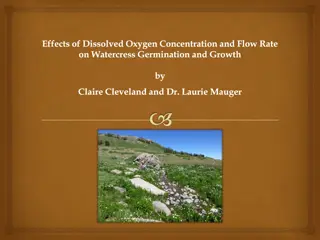Understanding Oxygen Diffusion Rate Measurement in Plant Roots
Measurement of oxygen diffusion rate in plant roots is crucial for assessing soil oxygen levels and aeration conditions. The Oxygen Diffusion Rate (ODR) method utilizes a platinum microelectrode to simulate roots, allowing for the calculation of oxygen flux at the root-soil interface. By monitoring the electrical current, the ODR method provides valuable insights into the respiration process of roots and its impact on plant growth.
Download Presentation

Please find below an Image/Link to download the presentation.
The content on the website is provided AS IS for your information and personal use only. It may not be sold, licensed, or shared on other websites without obtaining consent from the author. Download presentation by click this link. If you encounter any issues during the download, it is possible that the publisher has removed the file from their server.
E N D
Presentation Transcript
Measurement of Oxygen Diffusion Rate Respiration by plant roots depends on soil oxygen. Roots do not photosynthesize, and they give off carbon dioxide and take in oxygen during respiration. Diffusion of gases in the soil practically stops when the fraction of air-filled pores is less than 10%. Therefore, roots need at least 10% by volume air space in the soil to survive. Evaluation of the aeration conditions at the interface between the root and the soil system presents the greatest possibility of defining the influence of aeration on plant growth. The most widely used method to monitor aeration status of the soil, is the oxygen diffusion rate (ODR) method.
MODEL AND PRINCIPLES OF THE ODR METHOD Let us now consider the model, which is assumed in the ODR method. a cylindrical platinum microelectrode simulates the root. Around it are soil particles and the water film, which is right up against the root. If the electrical potential of the platinum microelectrode is lowered the oxygen at the microelectrode surface is reduced electrolytically until the oxygen concentration at the surface is zero. The reduction rate and the diffusion rate of oxygen are equal.
To determine ODR, we use the soil oxygen diffusion ratemeter. Which consist of the following components 1. The platinum microelectrode (Cathode) (0.65 mm diameter & 4 mm length) 2. The Ag-AgCl half-cell (reference electrode) 3. The anode 4. The electrical circuit 5. A milliammeter to measure the output current.
the applied electrical potential (volts) is between 0.3 and 0.7 V. In this range, the current is independent of the voltage and a function only of the diffusion rate of oxygen to the microelectrode surface. The resulting electrical current is expressed as follows: i = nFAfa,t Where: i = current (microamperes) n = the number of electrons required to reduce one molecule of oxygen (n = 4) F = Faraday constant (F = 96,500 coulombs /mole) A = surface area of the microelectrode fa,t= flux of oxygen at the surface of the microelectrode of radius a at time t
The oxygen flux (fa,t) is calculated by measuring the steady-state current (i) after 4 or 5 minutes, assuming that the rate of oxygen reduction is limited by the rate of oxygen diffusion and equal to it. The transport is strictly a diffusion process. ODR = fa,t= (60 Mi) / (nFA) ( g cm-2min-1) ODR = (60 * 32 * i) / (4 * 96500) * A = 0.00497 (i/A) Where: M = molecular weight of oxygen (M = 32 grams/mole) and is inserted to convert the units from mole to grams. i = the current A = the surface area of the microelectrode. A = ( d2h)
